Easter eggs are hidden all around the DMV! Pick from several Easter egg hunts coming up
Read the full article here.
As of March 31, tickets for all 3 date listings are sold out. Please join us again next year for Eggstravaganza!
TUDOR PLACE | Open Tuesday – Sunday. Currently on view TANGLED ROOTS. Click TICKETS for reservation times.
Tudor Place makes top listing for Easter events in the District.

by Makena Roberts | Wed, March 29th 2023
Read the full article here.
As of March 31, tickets for all 3 date listings are sold out. Please join us again next year for Eggstravaganza!
Shutterstock | Jefferson Memorial and Tidal Basin, Washington DC
Click here to read the full article
The Georgetowner
June 9, 2022

Tudor Place’s 30th Annual Spring Garden Party honored Dr. Sachiko Kuno, “committed scientist, philanthropist, entrepreneur and visionary,” as Executive Director Mark Hudson and President of the Board Mary Moffett Keaney introduced her May 25 to the applauding crowd, which enjoyed wine, cocktails and a buffet on the south lawn — a Georgetown tradition, co-chaired this year by Autumn Allen and Amy Porter Stroh.
To read the full article, click here.
New York Social Diary
June 2, 2022
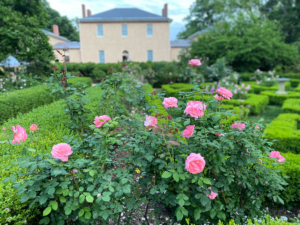
While selecting a theme for Tudor Place’s thirtieth annual garden party, the hosts didn’t look very far for inspiration-their own backyard provided more than enough.
To read the full article, click here.
The Georgetown Dish
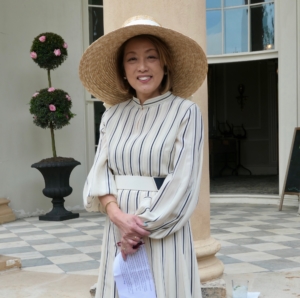
The 30th Annual Tudor Place Spring Garden Party on March 25, 2022 recognized Dr. Sachiko Kuno for her critical role in the community, inspiring others to engage with and support historic preservation.
To read the full article, click here.
The Georgetown Dish
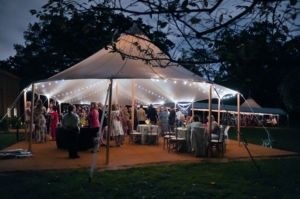
Join Tudor Place for the 30th Annual Spring Garden Party on Wednesday, May 25, 2022.
The Spring Garden Party has become the last party of Washington’s spring season and a sell out event for Tudor Place’s most generous friends – it is the organization’s most important fundraiser of the year. Proceeds support conservation of thousands of objects in the Tudor Place Collection & Archive, preservation of the 5 1/2 acre estate and dynamic educational programming for all ages.
To read the full article, click here.
The Peter family’s origins in Georgetown can be traced back to family patriarch Robert Peter. Born in 1726 at Crossbasket Castle, the Peter family’s ancestral seat near Lanarkshire, Scotland, Robert Peter arrived in the Maryland colony by 1746. His son, Thomas would marry Martha Parke Custis, one of the four grandchildren of Martha Washington (and step granddaughter of George Washington), and become the owners of Tudor Place in 1805. Learn more about Peter family history in this article that appeared in Bethesda Magazine.
Bethesda Magazine
The Georgetowner
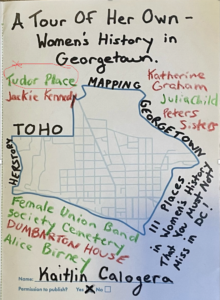
Hot off the presses — Congratulations to our very own Tour Of Her Own (TOHO) tour guides on publishing “111 Places in Women’s History in Washington, D.C.”!
Read the full article click here
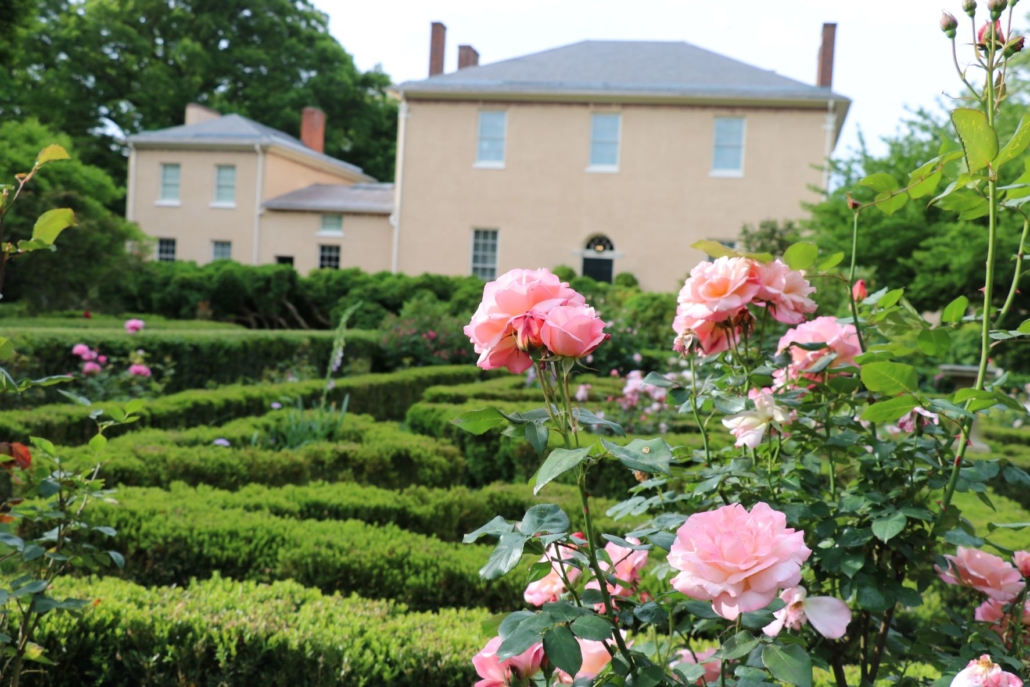
The Washington Post
Tudor Place reopens: Washington’s museums have had a rough few months, with staffing shortages and extended closures, but expect to see more openings than closings in coming weeks. Tudor Place, the landmark Federal-period mansion in Georgetown that holds the largest collection of items related to George Washington outside of Mount Vernon, reopens Friday for guided and self-guided tours. Reservations are suggested, and picnics are welcome on the grounds, which cover more than five acres. Visitors ages 12 and older touring the house must show proof of vaccination. Open Thursday through Sunday. $10 suggested donation for adults.
Anniversary Happy Hour and ‘Haus of Gaga’ Drag Show at Red Bear Brewing: Red Bear Brewing is turning three, making for a busy afternoon and night at the NoMa favorite. Start at happy hour, where the first 100 customers between 3 and 6 p.m. receive a free pint of beer or cider. (The brewery repeats the giveaway on Saturday and Sunday at 11 a.m.) Later on, drag host with the most Desiree Dik marks three years of drag shows at Red Bear with a Lady Gaga-themed party. Crystal Edge, Jayzeer Shantey and Erotica also take the stage. Arrive early for the “RuPaul’s Drag Race” viewing party, and stick around for the performance. “Drag Race” at 8 p.m., drag show at 9:30 p.m. Free.
Professional Women’s Hockey Players Association Secret Dream Gap Tour at MedStar Capitals Iceplex: While the Professional Women’s Hockey Players Association works toward the goal of establishing a professional hockey league in the United States, it has hosted showcase events with NHL teams in the United States and Canada. This weekend, the event is finally coming to the Capitals’ practice facility in Ballston. Four teams are competing in the tournament, representing Minnesota, Boston, Calgary and Toronto. In addition to the four games, the players are hosting three clinics for female hockey players of all skill levels. Tickets are $15 for the individual Friday and Saturday games, $25 for the two Sunday games, or $40 for a weekend pass. Through Sunday; times vary.
Folger Consort at St. Mark’s Church: The early music ensemble-in-residence of the Folger Shakespeare Library returns with a pair of spring concerts at St. Mark’s Church on Capitol Hill. On March 4 to 6, they’ll explore music from the earliest “Viennese School” — the court of Maximilian I — with a focus on works by 16th-century composer Ludwig Senfl, performed in new arrangements by composer David Froom and featuring tenor Steven Soph. Tickets are available for streaming and in-person attendance. Friday through Sunday. $35 in-person.
‘Kung Fu Hustle’ at Suns Cinema: The movie lineup at Suns Cinema is focused on martial arts in March, and it wouldn’t be martial arts month without a showing of the 2004 film “Kung Fu Hustle.” Riding off the success of “Shaolin Soccer,” director Stephen Chow helped usher in the modern day martial arts film with “Kung Fu Hustle,” which features older actors famous for their roles in 1970s Hong Kong action films. The film, set in the 1940s, is about two criminals, Sing and Bone, who want to join the Axe Gang, but instead end up making a bunch of enemies. 7 p.m. $10.
For the whole weekend rundown, click here.
by Curator Rob DeHart
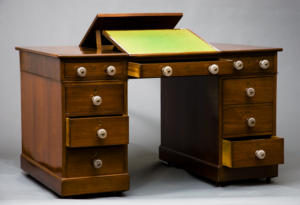
Partner’s Desk, probably WDC | MD, c. 1830-40. Walnut, tulip poplar, white pine, yellow pine. Tudor Place Historic House & Garden, 4049.01.
One of the standout pieces in the Tudor Place Collection is a partners’ desk that belonged to Francis Scott Key. Known primarily as the lyricist for the “Star-Spangled Banner,” Key was a prominent lawyer in Georgetown and served as District Attorney for Washington City from 1833 to 1841. The desk, which dates to the 1830s, likely saw Key through his district attorney years and witnessed one of the most violent instances of unrest in the city’s history.
In August 1835, an alleged threat by an enslaved Black man toward his female owner instigated days of rioting by whites that targeted Black businesses, churches and schools. Eventually called the “Snow Riot” after Black restaurateur Beverly Snow (whose business was destroyed by one of the mobs) it represented the culmination of years of racial and class tensions in the city and a central figure trying to resolve the effects of the chaos was Francis Scott Key. ¹
By 1835 the free Black population in Washington City had outgrown the city’s enslaved Black population. The city was becoming a destination for free Black entrepreneurs who desired access to African American-run institutions. This dynamic was one of many factors that combined to make the city rife with tension between whites and Blacks and ripe for the outbreak of violent riots that would erupt that summer.
It began on the evening of August 4 when 18-year-old Arthur Bowen left a debating society meeting led by prominent Black educator John F. Cook, Sr. His meetings were regular events where free and enslaved Blacks could gather and discuss slavery, temperance and other contemporary issues.
Slavery was certainly on Bowen’s mind because he was owned by prominent Washingtonian Anna Maria Thornton, whose late husband, Dr. William Thornton, had designed Tudor Place and the first U.S. Capitol building. Bowen learned how to read and write and moved about the city with relative independence, but much to the disappointment of his mother, Maria Bowen, his attentions were directed mostly toward horse racing and drinking. After the meeting, a very inebriated Bowen returned to the Thornton house on the north side of F Street between 13th and 14th Avenues. Rather than go straight to bed, he picked up an ax and approached the door of the bedroom shared by Anna Maria Thornton, her mother and Bowen’s own mother. He opened the door with the ax under his arm and shouted to the startled occupants, “I’ve got just as much right to freedom as you!” While his mother tried to restrain him, Anna managed to escape and alert neighbors, whose arrival drove Arthur off.
This incident played into the fears of many whites and slaveholders that free Blacks and abolitionists were loosening the chains of slavery in the city. To slaveholders, talk of emancipation only poisoned the minds of ‘docile slaves’ by giving them the impression that they could thrive outside the institution of slavery.
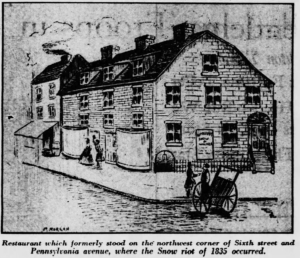
Evening Star Sept 25 1932
Four years earlier a rebellion of enslaved Virginians in Southampton County led by Nat Turner killed over 50 whites, validating (in the fearful eyes of white onlookers) the deadly risks of such ideas. The Bowen/Thornton incident was seen to further prove their fears correct. Bowen ended up in the city jail, but the fact that he had not harmed anyone was not enough to prevent a white lynch mob from descending on the jail. As District Attorney, Francis Scott Key deterred the mob by stationing a detachment of U.S. Marines at the jail. Their blood-lust thwarted, but still desiring to send a message to the city’s abolitionists and free Blacks, the mob took out its anger on Black owned businesses, homes and institutions, including Beverly Snow’s Epicurean Eating House on the corner of 6th and Pennsylvania Avenue. The destruction lasted for days and ended with the intervention of President Andrew Jackson.
The causes of the riot actually went much deeper than the Bowen/Thornton incident. While slaveholders feared the influence of abolitionists and free Blacks, it was white workers who did the actual rioting, and with different motivations than the slaveholders (though both freely used the city’s Black residents as scapegoats). White workers resented the city’s Black population because African Americans competed with them for jobs. White workers believed Black workers received more federal contracts because they accepted lower wages, perhaps not realizing that Black workers had little power to negotiate terms. Ironically, many white workers had equal disdain for the slave holding class, who they viewed as condescending and obstacles to the working class’s effort toward obtaining true political and economic power. In any case, white workers used rioting against the Black community as a way to vent these frustrations while risking minimal punishment.
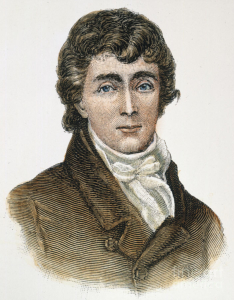
Francis Key Scott. Photo: Library of Congress.
When order was finally restored, it was up to Key as District Attorney to ensure that justice would be served and prevent future unrest. He had recently moved from Georgetown to a home in Washington City on C Street near 3rd Avenue. From this base and his office in city hall, he formulated the prosecution of Arthur Bowen, members of the white mob, and an abolitionist named Reuben Crandall who had recently been arrested for possessing a trunk full of anti-slavery literature. Justice would be served, but it became clear that it would not be distributed equally. Despite the pleadings of Anna Maria Thornton that Bowen had meant no harm on the night of the incident, Key succeeded in getting a guilty conviction with the sentence of death by hanging. Not to be deterred, Thornton took her case to President Andrew Jackson, who eventually issued a presidential pardon that permitted Bowen to avoid the death penalty and be sold to a slaveholder in Florida. Shortly after the sale, Thornton and Bowen stopped corresponding and the eventual fate of Bowen is unknown.
Key also aggressively went after abolitionist Reuben Crandall. A white schoolteacher who had recently moved from New York City, Crandall swore that he had no intention of distributing the abolitionist pamphlets that were found in his home. But Key and other slaveholders viewed abolitionists as even more dangerous than free Blacks for inciting rebellion in enslaved communities. Key himself was an advocate for colonization, the idea that the United States could end slavery by sending emancipated people to Africa. But he certainly did not believe in racial equality and feared what would happen if enslaved people were simply freed to live and function in white American society. In the end, Key was not successful with this prosecution; abolitionists funded Crandall’s defense and he was acquitted. The results of Key’s prosecution of the white rioters were mixed. He achieved 10 convictions, but all were released with fines and no jail time. Worse still is that none of the Black property owners were compensated for their losses. In fact, the city imposed new restrictions on free Blacks: to move to Washington City, a free black person had to post a $1000 bond approved by five white residents. The city also tried to restrict free Blacks to the trades of cart and carriage driving, but so many refused to follow the law that it was eventually struck down by the courts.
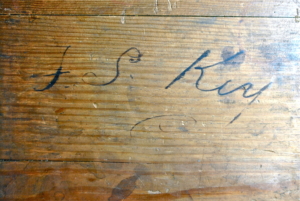
Detail of Partner’s Desk.
Key’s simple, sturdy partners’ desk manufactured by an unknown Washington, DC maker is one of the few remaining pieces of material culture that reflects his role during this critical time in the city’s history. Key’s initials appear on the top of the two pedestals, on which sits a broad top; they also appear on the bottom of several drawers. After Key’s death in 1843, the desk ended up with his friend and legal contemporary, James Dunlop Jr. It descended in that family before being sold to Armistead Peter Jr. in 1917, and has remained at Tudor Place ever since.
Peter desired the desk because of Key’s fame as the lyricist to the “Star-Spangled Banner,” but it also holds a much deeper meaning to Tudor Place today. Key’s role as District Attorney of a young and rapidly changing city, the Snow Riot and the successes and failures of Key’s justice are a poignant illustration of the city’s early and ongoing struggles with racism and inequality. Through it, we are offered an opportunity for reflection surrounding the efforts for equality that continue today.
[1] “Snow Riot” material drawn from Jefferson Morley, Snow-Storm in August: The Struggle for American Freedom and Washington’s Race Riot of 1835 (New York: Anchor Books, 2019); Chris Myers Asch & George Derek Musgrove, Chocolate City: A History of Race and Democracy in the Nation’s Capital (Chapel Hill: University of North Carolina Press, 2017).
Thank you for your interest in the Through their Eyes resource packet! Please provide your name and email address to download this valuable resource.
[wpforms id=”32425″ title=”false”]

